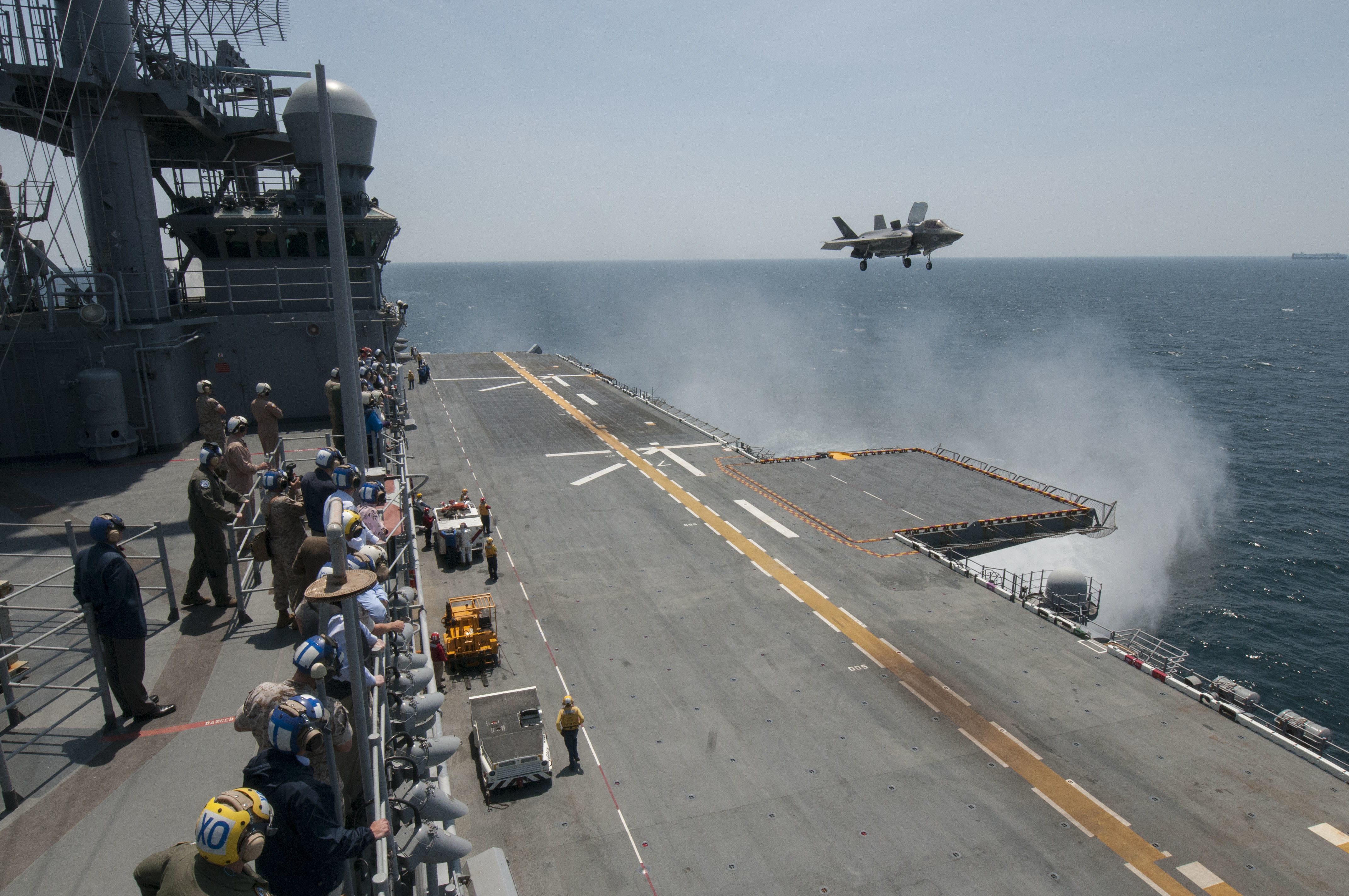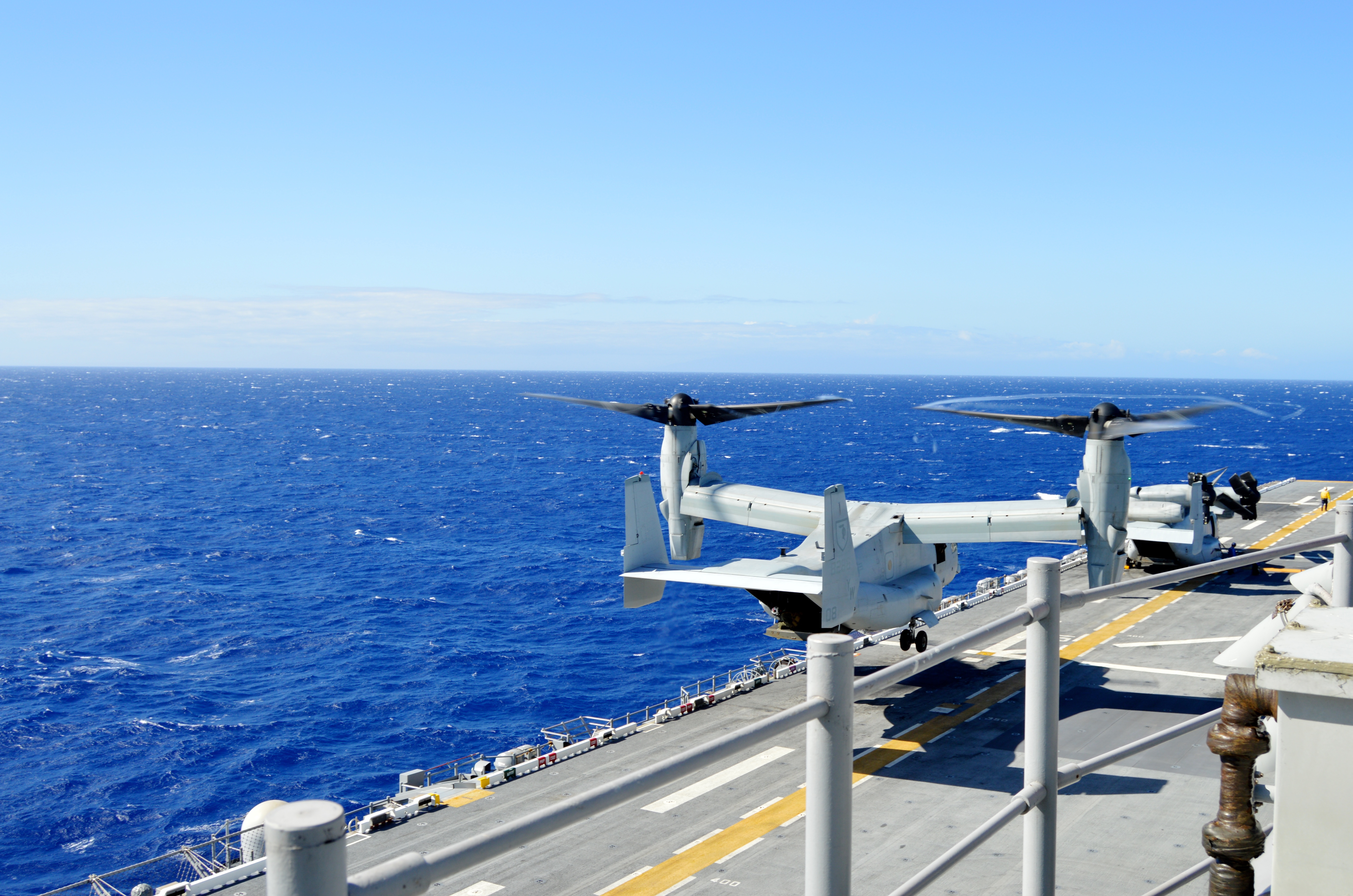
Amphibious assault ship USS America’s (LHA-6) deck crew is gearing up for F-35B Joint Strike Fighter testing this fall, with ship modifications for the new plane complete but crew training still ongoing.
The Navy and Marine Corps will test the new short-takeoff vertical-landing plane on the newest big-deck amphib in October. The ship came out of a maintenance availability in March with physical modifications to support the bigger and more powerful jet, but America‘s assistant air department head told USNI News aboard the ship last month that the crew would be busy preparing for F-35 in the intervening months.
The department plans to send 30 to 40 crew members to Marine Corps Air Station Beaufort in South Carolina for F-35B handling and firefighting training, Lt. Cmdr. Matthew Miller said. While the deck crew of the amphibious assault ships already handles both fixed- and rotary-wing aircraft, the JSF presents some unique challenges.
Noting that the F-35 stores its weapons internally to stay stealthy, the mini boss said that “normally the first thing we do if there’s a fire on deck is we put cooling water on the ordnance. Now if the ordnance is inside the aircraft, how are we supposed to cool the ordnance? This is a technical problem that we haven’t totally gotten the answer for yet, we’re hoping they’re going to come up with something. But in the mean time we’ll go there, we’ll get training on the uniqueness of the airframe, how to properly tie it down – being that it’s more composite than ever, the techniques you use on how to chain it down, how tight they are and everything else become more and more important so that we don’t mess up a $100-million jet.”
Some America leadership will go to Naval Air Station Patuxent River, Md., for tower training, Miller said, and immediately before F-35B comes aboard the ship the whole air department will go to NAS North Island, Calif., for hands-on training with the new aircraft.
In addition to personnel training, Miller said the amphib community is still trying to refine its hearing protection strategy for flight deck personnel. During F-35B operational testing aboard USS Wasp (LHD-1), personnel wearing cranials with built-in headsets struggled to hear above the larger, louder F-35 jet engines. After learning that lesson on Wasp, Miller said the America crew last month received a shipment of new headsets that will become standard equipment. Much like pilot helmets, these new cranials have ear buds that go into the ear, along with over-the-ear protection, creating double hearing protection that still allows personnel to communicate on the flight deck.
The mini boss said the crew would undergo training with the new headsets before the start of F-35B tests, and leadership would keep an eye out for lessons learned related to that new gear.
USS Essex (LHD-2) is currently in its midlife maintenance availability and while in the shipyard will receive the required upgrades to operate F-35B. Miller said the air bosses and mini bosses for all the amphibious assault ships communicate through regular group emails and share lessons learned, and as the Wasp crew passed along information from its testing, so will the America crew help get Essex ready for JSF operations when the time comes.

Among the lessons America has already learned and incorporated is that the physical JSF modifications have made MV-22 Osprey operations more efficient as well, Miller explained.
To prepare for the F-35, which is heavier than the AV-8B Harrier it replaces and produces a lot of heat and downwash when it lands vertically, the back of the flight deck was ripped up, strengthened from underneath and then put back together with a more heat-resistant non-skid coating, America commanding officer Capt. Michael Baze explained from the ship. That coating, called Thermion, is more expensive but lasts longer – and as a balance, Thermion was only used on the aft third of the deck for F-35B operations and near several landing spots where an Osprey’s right nacelle would be pointed downward at the deck.
Miller said the Thermion provides some benefit in the four landing spots where it was applied, but due to the extreme heat coming from the nacelles, Ospreys are still limited in how long they can keep the engines on and the nacelles vertical because the deck wasn’t strengthened from underneath and therefore the heat can still do damage in the long run.
On the back third of the deck, though, Osprey operations are virtually unlimited. Miller described a recent situation in which an Osprey “was about to launch, the nacelles were fully up, they’re not chocked and chained, and things just dragged out” due to a helicopter in need of maintenance right in front of the V-22.
“The nacelles were vertically up for 15 or 20 minutes, and normally that would have just destroyed the non-skid, it probably would have just come up with a spatula. But the new (Thermion) held up, it held up beautifully.”
Miller said America has more landing spots with the Thermion coating than does Wasp, which has increased operational flexibility and efficiency on the ship.





